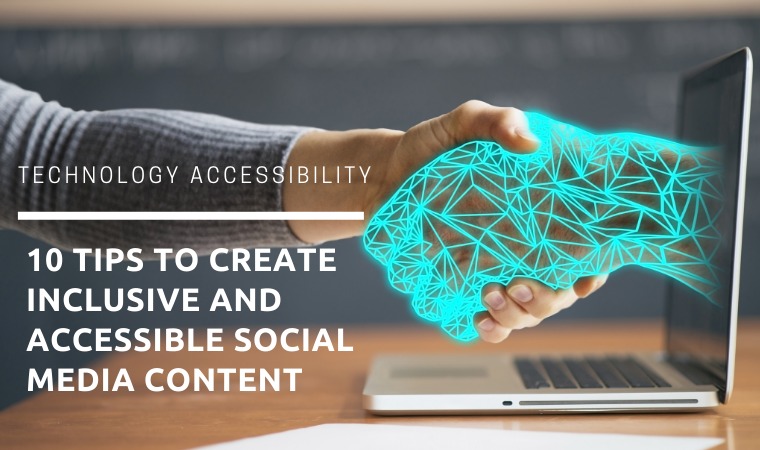Over the past decade, the explosion of social media platforms and their incredible influence on the public has expanded public relations professionals’ purview to encompass this relatively new medium of great importance to our clients. Social media and digital content delivery models are growing at a breakneck pace. However, their development primarily focuses on a one-size-fits-all approach, increasing the barrier to usage for individuals with disabilities.
According to the World Bank, at least 1 billion people, 15% of the world’s population, experience some form of disability — not accounting for temporary and situational disabilities.
Approaching social media content development with inclusive design and accessibility in mind helps communication professionals represent and connect with our clients’ full potential audiences, ensuring that someone with a disability can access content as effectively as someone who does not.
Accessible content is essential for those who rely on adaptive technology solutions to use social media and include technologies for those that are blind or visually impaired, deaf and have hearing loss, and people with cognitive learning disabilities. According to Level Access, those who use adaptive technology to consume social media content report common challenges such as:
– Lack of section headings
– Poor color contrast
– Inability to navigate using keyboard only
– Failure to operate functionality using keyboard only
– Missing text equivalents for images
– Inability to resize text
– Videos lacking captioning
In recognition of National Disability Employee Awareness Month, keep in mind these ten tips for creating more inclusive and accessible social media content:
Supply Information on Multiple Channels: Provide access to the same information on a variety of brand platforms including, websites, newsletters, and varying social media platforms.
Write in Plain Language: Try writing in plain language following the Plain Writing Act of 2010 that ensures that all content is “clear, concise and well-organized.” If possible, avoid using acronyms that would sound unfamiliar when read by a screen reader.
Limit Emojis to 3 or Less: Emojis are a fun way to make your posts pop on social media, but they can be confusing and overwhelming for those using screen readers. For example, for someone using a screen reader 😄🔥❤️ would sound like “Grinning Face with Big Eyes, Fire, Red Heart.” If you must use emojis, place them at the end of your text and limit them to three.
Include Video Captions: Video captions are critical to those with hearing impairments, those watching in their non-native language, and for viewers and sound-off environments.
Provide Alternative Text: Provide short, detailed descriptions for every image to help those using screen readers understand what is happening in a picture.
Use a color contrast of at least 4.5:1: For those that are colorblind, color contrast is vital. Color contrast should be set at least 4.5 to 1, with larger text using a ratio of 3 to 1; additionally, avoid using color to convey feelings or emotions and instead do so with descriptive text.
Capitalize Hashtags: A simple way to improve accessibility on platforms like Twitter and LinkedIn is utilizing CamelCase for hashtags, meaning capitalize the first letter of each word in a hashtag. Screen readers see hashtags that are uncapitalized as a string of letters versus individual words.
Use Inclusive Language: Try to avoid language that is not wholly inclusive. Leverage gender-neutral pronouns and share diverse voices.
Stay informed about accessibility tools: Stay up-to-date on changes to accessibility guidelines and utilize platforms that aid in developing accessible content such as WAVE Browser extensions, Hemmingway Editor, Microsoft Accessibility Checker, Thread Reader App, Image Alt Text and Alt Text Reader.
Welcome feedback! Humans rarely get it right the first time; be open to changing direction! Experience shapes perspective, keep learning and try to reach out to those available to share their experiences.
Stanton Communications is proud to work with federal agencies like the U.S. Department of Veterans Affairs (VA), that are at the forefront of accessibility guidance and inclusive design. VA’s Office of Information and Technology recently developed an accessibility toolkit that provides explicit instruction to all stakeholders interested in creating inclusive digital content.
Developing inclusive and accessible social media content only requires a few extra simple steps and pays dividends in brand reputation, expanded reach and effectiveness of public relations campaigns. Utilizing accessible content is also a sign of respect for those with disabilities and attractive to those without. In fact, a recent Google survey found that 64% of people are more likely to interact with an inclusive ad over one that is not. Learn more about developing inclusive and accessible social media content with these resources:
Inclusive Design for Social Media: Tips for Creating Accessible Channels (hootsuite.com)
Improving the Accessibility of Social Media in Government – Digital.gov
Federal Social Media Accessibility Toolkit Hackpad – Digital.gov
Additional sources referenced in this article:
How accessible is social media if you have a visual impairment? – Life of a Blind Girl
6 Ways to Make Your Social Media Posts More Accessible — Flagship Social
Why Your Social Media Needs to be More Inclusive – Media Cause
AEM Center: Creating Accessible Social Media Posts (cast.org)
Web Content Accessibility Guidelines (WCAG) Overview | Web Accessibility Initiative (WAI) | W3C
Perceptions on diversity & inclusion – Think with Google
Eliza Levy is a Senior Account Manager at Stanton Communications. She is a dyslexic writer and leveraged Nuance’s Dragon Dictation Software and Grammarly to write this article.
